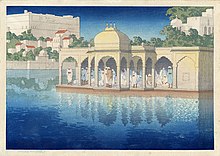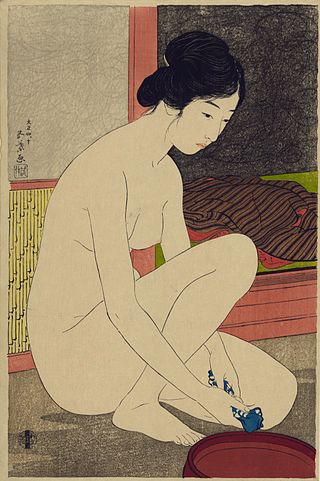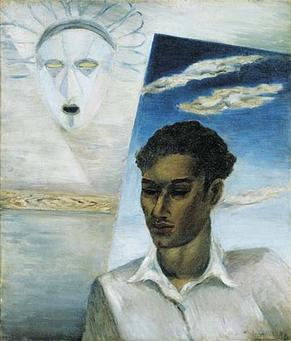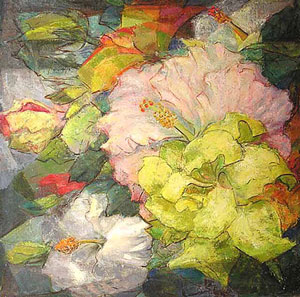





Charles William Bartlett (1 June 1860 –16 April 1940) was an English painter and printmaker who settled in Hawaii.






Charles William Bartlett (1 June 1860 –16 April 1940) was an English painter and printmaker who settled in Hawaii.
Bartlett studied metallurgy and worked in that field for several years. At age 23, he enrolled in the Royal Academy in London, where he studied painting and etching. After three years of study in London, he entered the private studio school Académie Julian in Paris, where he studied under Jules Joseph Lefebvre (1836–1911) and Gustave Boulanger (1824–1888). [1]
In 1889, he returned to England and married Emily Tate, but shortly thereafter, his wife and infant son died in childbirth. Bartlett then traveled to Europe, spending several productive years in the Netherlands, Brittany and Venice with his friend and fellow artist Frank Brangwyn (1867–1956). Brangwyn is believed to have introduced Bartlett to Japanese prints. [2] Bartlett produced some of his most important early works on the Continent, especially studies of peasants painted in broad areas of colour. He was invited to join the Société Nationale des Beaux-Arts in France in 1897. In 1898, he returned to England and married Catherine "Kate" Main. Bartlett returned to the Continent with his second wife, and in 1908, he helped found the Société de la Peinture a l'Eau in Paris. Several Continental museums acquired his paintings at the Paris exhibitions of the Société de la Peinture a l'Eau. [3]
Bartlett made several trips to Brittany and the Netherlands with the Dutch painter Nico Wilhelm Jungmann (1872–1935), which provided the former with material for future paintings of peasants, whose dignity derived from the simple placement of shapes. [2]
In 1913, with financial backing from his wife's well-to-do family, the Bartletts traveled to India, Ceylon, Indonesia, China, and Japan. He arrived in Japan in 1915, where he met woodblock print publisher Watanabe Shōzaburō (1885–1962), who was a major force in early 20th-century Japanese art (shin-hanga). In 1916 Watanabe published 21 woodblocks from Bartlett's designs, including six prints of Japanese landscapes. In 1917, Bartlett and his second wife left Japan for England; however, they stopped off in Hawaii, where they remained—never returning to England. He did visit Japan in 1919, where he created sixteen shin-hanga prints for Watanabe.
Anna Rice Cooke (1853–1934), who founded the Honolulu Museum of Art, became Bartlett's advocate and patron. [4] In 1928, Bartlett helped to found the Honolulu Printmakers along with local artists Alexander Samuel MacLeod, John Melville Kelly, and Huc-Mazelet Luquiens. [5] Charles Bartlett died in Hawaii at the age of 79 on 16 April 1940.
The Bradford Museums and Galleries (West Yorkshire, UK), the Bristol City Museum and Art Gallery (Bristol, England), the Cleveland Museum of Art, the Honolulu Museum of Art, the Library of Congress (Washington, D. C.), and the Jordan Schnitzer Museum of Art (University of Oregon) are among the public collections holding work by Charles W. Bartlett.
The Honolulu Museum of Art holds a large collection of Charles Bartlett's paintings and prints, and has held eight solo exhibitions of his work: [6] [7]

Hasui Kawase was an artist, one of modern Japan's most important and prolific printmakers. He was a prominent designer of the shin-hanga movement, whose artists depicted traditional subjects with a style influenced by Western art. Like many earlier ukiyo-e prints, Hasui's works were commonly landscapes, but displayed atmospheric effects and natural lighting.

Shinsui Itō was the pseudonym of a Nihonga painter and ukiyo-e woodblock print artist in Taishō- and Shōwa-period Japan. He was one of the great names of the shin-hanga art movement, which revitalized the traditional art after it began to decline with the advent of photography in the early 20th century. His real name was Itō Hajime.

Shin-hanga was an art movement in early 20th-century Japan, during the Taishō and Shōwa periods, that revitalized the traditional ukiyo-e art rooted in the Edo and Meiji periods. It maintained the traditional ukiyo-e collaborative system where the artist, carver, printer, and publisher engaged in division of labor, as opposed to the parallel sōsaku-hanga movement.

Sōsaku-hanga was an art movement of woodblock printing which was conceived in early 20th-century Japan. It stressed the artist as the sole creator motivated by a desire for self-expression, and advocated principles of art that is "self-drawn", "self-carved" and "self-printed". As opposed to the parallel shin-hanga movement that maintained the traditional ukiyo-e collaborative system where the artist, carver, printer, and publisher engaged in division of labor.

Shikō Munakata was a woodblock printmaker active in Shōwa period Japan. He is associated with the sōsaku-hanga movement and the mingei movement. Munakata was awarded the "Prize of Excellence" at the Second International Print Exhibition in Lugano, Switzerland in 1952, and first prize at the São Paulo Bienal Exhibition in Brazil in 1955, followed by Grand Prix at the Venice Biennale in 1956, and the Order of Culture, the highest honor in the arts by the Japanese government in 1970.

Goyō Hashiguchi was an artist in Japan. At the forefront of the shin-hanga movement, a revival of ukiyo-e, he designed fourteen woodblock prints which are regarded as masterpieces of the genre.

Hiroshi Yoshida was a 20th-century Japanese painter and woodblock printmaker. He is regarded as one of the greatest artists of the shin-hanga style, and is noted especially for his landscape prints. Yoshida travelled widely, and was particularly known for his images of non-Japanese subjects done in traditional Japanese woodblock style, including the Taj Mahal, the Swiss Alps, the Grand Canyon, and other National Parks in the United States.

Hiroki Morinoue is an American artist of Japanese descent who has helped to pioneer in the United States the fusion of western Impressionism with modern Japanese design.

Isami Doi was an American printmaker and painter.

Shirley Ximena Hopper Russell, also known as Shirley Marie Russell, was an American artist best known for her paintings of Hawaii and her still lifes of Hawaiian flowers. She was born Shirley Ximena Hopper in Del Rey, California, in 1886. She graduated in 1907 from Stanford University, where she discovered art. Shirley married Lawrence Russell, an engineer, in 1909. When he died in 1912, she began teaching in Palo Alto, and dabbling in painting. In 1921, she and her son came to Hawaii for a visit and decided to stay. She studied under Hawaiian artist Lionel Walden during the 1920s and traveling to Europe several times to further her art education. She studied in Paris during the 1930s and the cubist influence can be seen in a number of her works. She taught art at President William McKinley High School in Honolulu for more than 20 years. Around 1935-1936, the Japanese publisher Watanabe Shozaburo (1885–1962) published more than several woodblock prints she designed. The majority of these prints depict colorful and detailed tropical flowers, while at least one print, Carmel Mission, is a California landscape.

Shōzaburō Watanabe was a Japanese print publisher and the driving force behind one of the woodblock printmaking movements known as shin-hanga.

Hiroyuki Tajima was a Japanese printmaker of the sōsaku-hanga school. He was born in Tokyo and graduated from Nihon University in 1932. In 1943, he graduated from the Western-style painting division of the Tokyo School of Fine Arts. He created his first print in 1946, and joined the Bijutsu Bunka Kyokai the same year. He also studied Nagase Yoshi (1891–1978), an artist of the Sōsaku-hanga school. In 1963, he became a member of the Nihon Hanga Kyokai.
Yasuhide Kobashi was a Japanese woodblock print artist, painter, sculptor and stage designer. He was born in Kojima in Okayama Prefecture. His father was a ceramic artist and head of the Kyoto Industrial Craft Company. Kobashi learned printmaking from the sōsaku hanga master Unichi Hiratsuka (1895–1997). In 1955, Kobashi graduated from the Kyoto College of Crafts and Textiles, and in 1959, he moved to New York City. Nelson Rockefeller was Kobashi's patron, and acquired one of the artist's sculptures for the New York State Executive Mansion in Albany.

Takahashi Shōtei (高橋松亭), born Hiroaki was a 20th-century Japanese woodblock artist in the shinsaku-hanga and later shin-hanga art movements.

Yamakawa Shūhō was a Japanese painter active in the Taishō and Shōwa eras, as well as a printmaker of the Shin-hanga movement. He was born in Kyoto with the name Yamakawa Yoshio. His first teacher, Ikegami Shūhō (1874-1944), gave him the name Yamakawa Shūhō. Yamakawa then went on to study with Kiyokata Kaburagi. He also worked as an illustrator in the 1930s. In the late 1920s, he started designing woodblocks prints of beautiful women, many of which were published by Shōzaburō Watanabe. Yamakawa died of a cerebral hemorrhage in 1944.
Reika Iwami (岩見 禮花 Iwami Reika, was a Sōsaku-hanga woodblock printmaker who worked primarily with abstract compositions.
Kitaoka Fumio was a Japanese artist. He was trained in oil painting, and later became interested in woodblock printing.
Umetaro Azechi was a Japanese printmaker and mountain climber. He was known for his prints of mountains and people who live in them.

Shiro Kasamatsu was a Japanese engraver and print maker trained in the Shin-Hanga and Sōsaku-Hanga styles of woodblock printing.
Ansei Uchima was an American artist and teacher primarily known as a sōsaku-hanga woodblock printmaker who employed traditional ukiyo-e Japanese techniques to produce abstract works covering a range of distinct personal styles.
![]() Media related to Charles W. Bartlett at Wikimedia Commons
Media related to Charles W. Bartlett at Wikimedia Commons